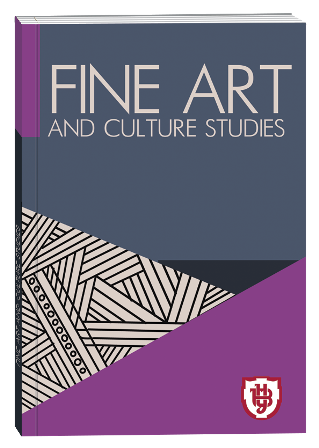INTEGRATED ACCOUNT OF WET ARCHITECTONS: INTERCONNECTING THE COMPONENTS IN A SPECIAL STYLE
DOI:
https://doi.org/10.32782/facs-2023-4-18Keywords:
personal style, self-attitude, visual consistency, self-concept, style components, architectonicsAbstract
The purpose of the article is to study the features of the formation of the architectonics of one's own image based on the construction of relationships between the components of personal style. The research methodology is based on the use of an integrated approach, which is due to the specifics of the chosen topic and the need to consider all its aspects.An important role in the study was played by the use of psychological methods to study the self-concept as a set of settings for designing a person's external appearance. Culturological methods made it possible to determine the features of the concept of one's own image, its place in modern culture and human life. The adaptation of the design methodology in the fashion industry to modern needs and challenges led to the involvement of the basic principles of imageology. In general, the study is based on the study of theoretical sources and practical heritage on the chosen topic. The scientific novelty consists in the use of the "I-concept" to create the architecture of the image. This approach is based on determining the special features of a person not only in his appearance (type of face, physique), but also manifestations of character (personal qualities, charisma, etc.). The architectonics of an image is understood as its construction – a structure on which other additional elements are superimposed. Thanks to this, we get a solid image and can talk about our own style. Conclusions. The author emphasizes that the common problem of society at present is the formation of a number of stereotypes regarding the image as a complex image of a person. In order for the created image not to be purely indicative, artificial, it must be based on its own style, which, in turn, follows from the image. The image in design allows you to talk about the characteristic features that have a certain message, thanks to which the image is read. Architectonics allows you to implement the concept of the image in the material, it is the basis for building the entire image, which becomes the basis for creating your own style. The image is formed according to the self-concept of a person, which allows taking into account the main characteristics: appearance, temperament, charisma, color type. Style is determined by a set of interconnected components that additionally combine the personality of a person, his individuality. The subordination of parts and the integrity of the image are the main conditions for harmony. Further research can be aimed at creating an algorithm for determining the "I-concept" taking into account modern trends in the development of fashion.
References
Винничук М.С., Колосніченко М.В. Образно-стильові особливості прикрас і доповнень в «системі костюм». Дизайн одягу в полікультурному просторі : монографія / М. В. Колосніченко, К. Л. Пашкевич, Т. Ф. Кротова та ін. Київ : КНУТД, 2020. С. 132–148. URL: https://er.knutd.edu.ua/handle/123456789/16296
Волинець Н. Я-концепція як чинник особистісного самовизначення в ранній юності. Наукові праці Міжрегіональної академії управління персоналом. Психологія. 2022. № 1 (54). С. 27–34. DOI: 10.32689/maup.psych.2022.1.4
Гринник І. Мода як засіб самопрезентації особистості. Проблеми гуманітарних наук. Психологія. 2020. № 47. С. 42-47. DOI: 10.24919/2312-8437.47.229344
Дихнич Л.П., Тітенок А.В. Мода в системі самоідентифікації особистості. Innovative trends in science, practice and education: Proceedings of the VII International Scientific and Practical Conference, Munich, February 22 – 25, 2022, Munich, Germany, 2022. С. 88-91. DOI: 10.46299/ISG.2022.I.VII
Кузнєцова В. Арт-об’єкт як специфічна художня форма в сучасній українській моді. Вісник Київського національного університету культури і мистецтв. 2022. № 47. С. 163–170. DOI: 10.31866/2410-1176.47.2022.269631.
Лагода О.М. Репрезентативний потенціал дизайнерських практик у симбіозі мистецтва і моди. Art and Design. 2018. № 3. С. 107–119. DOI: 10.30857/2617-0272.2018.3.10.
Михайлова Р.Д., Федорова Є.В. Про зміст і співвідношення понять «образ» та «імідж». Вісник Київського національного університету культури і мистецтв. 2016. № 35. С. 206–217. DOI: 10.31866/2410-1176.35. 2016.158260
Осадча А. Удосконалення дизайн-проєктування одягу. Народознавчі зошити. 2018. № 3 (141). С. 731–737.
Патлашенко О. Образно-асоціативне рішення композиції сучасного костюму. Актуальні проблеми сучасного дизайну : зб. матеріалів Міжнародної наук.-практ. конференції, м. Київ, 20 квітня 2018 р. Київ: КНУТД, 2018. Т. 1. С. 238–241.
Ясієвич В. Про стиль і моду. Київ : Мистецтво, 1968. 136 с.
Barthes R. Éléments de sémiologie. Communications. 1964. 4. Р. 91–135.
Borysov R. Max Weber and Modernity: modernization, rationalization, legitimation. Ukrainian Sociological Journal. 2020. № 24. Р. 14–22. DOI: 10.26565/2077-5105-2020-24-02
Hajinsky. URL: https://hajinsky.com/
James W. Principles of Psychology. New York : Henry Holt and Company, 1890. 701 р.







